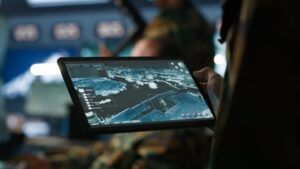The United States has ceded its leadership position in space-based positioning, navigation and timing (PNT), with stark ramifications for most all U.S. critical infrastructures and the U.S. military.
The Global Positioning System (GPS), which is owned and operated by the U.S. government, is vital to America’s well-being, prosperity and security in an increasingly competitive and dangerous world. The majority of the current satellite constellation is comprised of old space vehicles, with the oldest launched in the 1990s. Of the 31 satellites in the current GPS constellation, only seven are the more advanced GPS IIIs with better accuracy and the civilian L1C signal, which enables interoperability between GPS and international satellite navigation systems.
China’s Beidou and Europe’s Galileo satellite systems not only have surpassed GPS, but GPS is vulnerable to a variety of threats such as jamming and spoofing –sending false signals to receivers in place of valid ones.
Vital to national security and the economy
Satellite navigation is essential for U.S. civil, scientific and commercial activities as well as homeland security and national defense.
GPS has transformed Americans’ way of life. All 16 critical infrastructure sectors, including agriculture, emergency services, energy, financial services, information and communications and transportation, rely upon GPS. From enabling precision farming, synchronizing financial transactions and cell phone networks, increasing the safety of land, rail, maritime and flight operations, to enabling first responders to navigate accurately to emergencies, GPS impacts our daily lives.
In addition, GPS is a force multiplier that has significantly increased the operational effectiveness of the U.S. armed forces. It allows deployed forces to maneuver, synchronize and mass effects from dispersed locations in multi-domain, non-linear operations. GPS enables the United States to project power with unprecedented speed, accuracy and lethality.
Foreign satellite systems are more advanced
Beidou and Galileo are either more accurate or provide better coverage in parts of the world than GPS. Beidou, for example, has a larger satellite constellation in multiple orbits, more ground antennas, signal post-processing and a text messaging service for communications.
Moreover, as evidenced by ongoing conflicts in Europe and the Middle East, adversaries are jamming and spoofing GPS. Extensive jamming and spoofing reported by commercial airline pilots, warship crews and merchant ships among others prompted officials to warn that it is endangering shipping and air travel. Adversaries have jammed GPS in Ukraine, the Baltics, the Black Sea, South China Sea, Philippine Sea, eastern Indian Ocean, northwest of Australia and near South Korea. Adversaries have spoofed GPS in Eastern Europe, Scandinavia, Russia, Gaza, southern Israel, Iran, Turkey, China and Pakistan.
The U.S. originally envisioned capability enhancements to improve performance and counter such interference as part of the GPS modernization effort decades ago, but they were delayed or not fielded. Concerns that the Department of Defense’s acquisition process for space-related projects “was broken” after the turn of the century caused officials to direct the GPS program to “go back to basics.”
Part of that effort meant the Defense Department changed specifications to incorporate less technologically risky upgrades. The focus was on restoring confidence in defense space acquisition management among the program’s overseers in Congress and the executive branch.
The press for more modern GPS satellites
Deploying more modern GPS satellites is essential for recovering America’s leadership in satellite navigation. The GPS IIIF (or Follow-On) satellite program will deliver both enhanced capability and strengthened resilience against foreign threats to the freedom of passage through and operations in space. Ten satellites are already in production, and the first vehicle will be available for launch in January 2027.
A new digital navigation payload will enhance the GPS IIIF spacecraft’s performance. It will boost the satellite’s accuracy, reliability and signal strength. It will also have a new search and rescue (SAR) capability. The SAR capability with continuous access worldwide will enable the satellites to receive distress calls and relay them to facilitate emergency responses.
The GPS IIIF’s will have improved survivability, endurance and operational continuity due to a more resilient satellite with enhanced cyber security, power, propulsion and electronics. Unlike the existing GPS satellites, the new version will allow for servicing upgrades while in orbit.
Another key enhancement for the new satellites is improved encryption with military M-code signals and Regional Military Protection (RMP) that provides up to 60 times greater anti-jam capability.
R-GPS not the answer for improving resiliency
The U.S. Space Force (USSF) recently used a “quick start” authority granted by Congress to initiate acquisition of a fleet of smaller satellites that will be interoperable with the existing GPS constellation as part of a new Resilient-GPS program. R-GPS is intended to improve resilience by augmenting the GPS constellation with a network of small satellites in medium Earth orbit.
Yet since the space force initially proposed the program, there may be temptation to fund R-GPS at the expense of GPS IIIF because of fiscal constraints. This will adversely impact getting the better PNT capability on-orbit as soon as possible and could hurt the long-term health of the constellation.
Additional satellites beyond the existing 31 vehicles in the constellation will improve coverage and should strengthen resilience against kinetic threats if the cost-exchange ratio favors the defender; that is, if it is less expensive for the U.S. to build R-GPS satellites than it is for adversaries to build anti-satellite, counterspace or navigation warfare weapon systems. It may also help to complicate an adversary’s risk calculus and targeting as well as buy time to improve endurance against kinetic weapons.
The main threats to GPS, however, are adversary cyber weapons and electronic warfare systems. R-GPS will not strengthen resilience against either of those threats. Indeed, more satellites create more attack surfaces and vectors for cyber-attacks, and without the RMP capability planned for the more advanced GPS spacecraft, R-GPS satellites will have less anti-jam capability.
The way forward for GPS
While the intent of a more resilient R-GPS program to augment GPS is laudable, as currently defined it will not provide an effective solution to the threat. In fact, investing in a new system that will not strengthen resilience against the primary threats to the GPS constellation at the expense of a more effective and resilient capability would be imprudent.
A better way is to leverage the sunk investment in GPS IIIF and increase the number of satellites on-orbit with improved performance and resilience against cyber, electronic warfare, kinetic and nuclear weapons. The focus should be on adding additional satellites that are more resilient and assured to be compatible with the existing ground infrastructure.
Furthermore, the ability to service and upgrade GPS IIIF satellites on-orbit, including with new countermeasures as threats evolve, will help to obviate the need to launch satellites into a hostile environment to reconstitute capability lost in combat.
Given the urgent need to be ready for a hostile operating environment, the USSF should consider:
- buying multiple GPS IIIF vehicles in a single procurement to reduce costs,
- adding crosslinks that enable satellite-to-satellite data relay without having to go down to a ground station,
- pivoting from launching for sustainment to launching for capability, and
- deploying spacecraft into both medium and geosynchronous Earth orbit to strengthen resilience for critical infrastructures, national essential functions and military operations.
Modernizing GPS as originally envisioned will restore America’s competitive advantage in satellite navigation.







